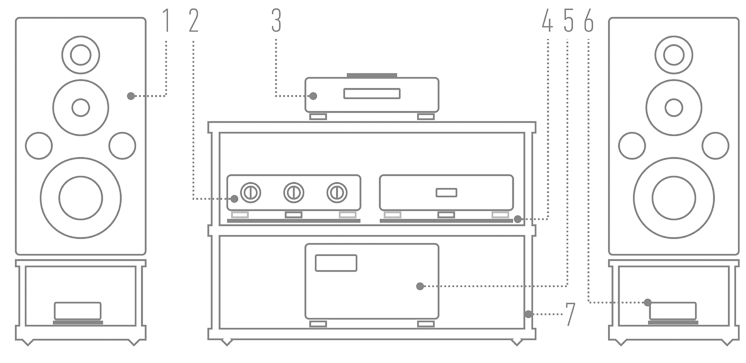|
HEADPHONES ⸜ open-back planar FOSI AUDIO
Manufacturer: FOSI AUDIO |

|
Review
text WOJCIECH PACUŁA |

|
No 255 August 1, 2025 |
THE HEADPHONES IN QUESTION were created thanks to a crowdfunding campaign on Kickstarter. Let me remind you that we're talking about a platform designed for raising money for various types of projects, from industrial to artistic ones. Creators set a financial goal and a time limit for their campaign, and potential sponsors can donate money to support the project and receive rewards in return. If the project reaches its funding goal within the specified time, the creator receives the promised funds and the project can continue. 
It seems simple, but it's not. As the portal Strefa Inwestorów notes already in their article title: "Kickstarter is not easy money", adding that Polish crowdfunding campaigns are not doing well on this platform; more → HERE. Inn Poland says that, in a flood of praise, campaigns of this type help companies acquire the first customers and distributors, build the brand, generate investor interest and validate the business model – but much less is written about problems connected with running such a campaign; more → HERE. The Chinese brand whose headphones we are testing seems to be doing well in this regard. It has extensive experience, having previously run six other campaigns, all of which far exceeded their targets. So, it seems it knows how to avoid the pitfalls that other companies get stuck in and take advantage of the benefits that this type of action offers. It's a perfect way to build a loyal fan base who feel involved in the decision-making and production process and can even feel, in a way, like co-owners of the brand. This is because donors supporting a given project or product usually receive either rewards or the products they supported at a significantly lower price. In the case of the Fosi Audio i5 headphones, we're dealing with the latter, because instead of the planned $500 after the campaign ends and the product is put on sale, they are offering them for just $389. When I took a closer look at the headphones in question, I realized that regardless of whether it's a lower or higher price, it's still a bargain. And that, I believe, was the company's main goal with the i5 headphones: to offer high-end solutions for which you would have to pay two, or perhaps even three times more elsewhere. This seems to be confirmed in the opening paragraph on their dedicated website (bold added by the Editors):
▌ The i5 THE MANUFACTURER describes their first headphone model in the following way: “open-back planar magnetic headphones” and assures us that they offer “long-lasting luxurious sound impressions” and that they are “Hi-Fi headphones for serious audiophiles”. It's hard to disagree with that, even after a long search for a loophole. The i5s are open-back headphones. There are also designs with an orthodynamic structure. This term was coined and popularized in the 1970s by Yamaha when advertising their HP-1 headphones. So, we have the operating principle, the design and the placement method. When we say "orthodynamic," we mean those that use a transducer often called isodynamic ("applying equal force to the entire surface") or planar, combining the characteristics of dynamic and electrostatic transducers. The principle of operation of such a transducer is based on placing a flat membrane with a sputtered conductive coil in a magnetic field. Under the influence of the current (signal) flowing through it, it moves, generating an acoustic wave. A magnetic field can be generated by electrodes to which a high voltage is applied – then we are dealing with electrostatic headphones, or by permanent magnets – in such a case, we are talking about magnetostatic headphones. That's precisely the kind of designs we're dealing with this time. 
The Fosi Audio i5s are beautifully crafted designs. Just a glance at them is enough to know that the design of their appearance was modeled after headphones like those from HiFiMan, e.g., the HE-1000 v2 model, which I've been using for years; more → HERE. The earcups are oval-shaped, protected by aluminum covers cut on CNC machines, and the headband is made of steel used, according to the manufacturer, in the aerospace industry. The same goes for the part of the headphones that rests on your head. It is made of leather and is attached to a "sled" that we use to adjust the headphones to the shape and size of the head. The manufacturer says that these "sleds" are made specifically for this model and have silicone elements inside that allow for smooth, stepless sliding while also providing a strong "grip". The headphone housing is made of American walnut wood. Fosi Audio points out that this porous material was chosen after numerous listening tests and trials for its acoustic properties, specifically its ability to dampen vibrations. We attach the cups to the headband – in a cool way, using Velcro. The earcups are quite deep because the designers wanted to position the drivers slightly away from the ears. The front is made of soft material, the sponge has shape memory, and the outer part is porous artificial leather. The drivers themselves are really large – their diameter is 97 mm. The diaphragm on which the coils are placed is ultra-thin, only 2 μm; this was done to make it as light as possible and thus allow it to respond to signal changes as effectively as possible. The coils, for the record, are silver and have rounded edges, which is meant to help with undistorted signal flow. To be honest, it's true – Luxman and Soulution have been designing their printed circuit boards this way for years. Twenty-two neodymium rods were used to polarize the coil, positioned on both sides of the diaphragm. Let me remind you that there are two methods: one says it's better to place them only on one side, and the other says on both sides. The former argues that although it's a less efficient system, there are no elements between the diaphragm and the ear that disrupt the airflow. Additionally, the rods increase the weight of the already heavy structures. That's why HiFiMan occasionally introduces improvements to the shape of the magnets, most recently in the form of Stealth Magnet technology. The latter says that this is the only way to properly control a flat diaphragm. We feed signal to the headphones with a short cable which is 151.13 cm long (the manufacturer specifies the exact length: 59.05 inches), terminated with mini-jack stereo plugs, one for each headphone. It is made of 1120 silver-plated 5N copper wires twisted together. The set includes two cables, one for unbalanced connections and the other for balanced ones. The first one is terminated with a 3.5 mm stereo mini-jack plug, and the second one with a 4.4 mm Pentaconn plug. The first one has an adapter for a 6.35 mm (large jack) TRS plug. We can also order a better balanced cable where the conductor is copper coated with a layer of graphene. 
The headphones have a low impedance of 28 Ω, so they will be an easy load for any amplifier. Their frequency response is supposed to be from 10 Hz to 50 kHz, and their sensitivity is 98 dB/mW (at 1 kHz), which is quite a high level. So, we won't need powerful amplifiers to drive them. The manufacturer does mention a power output above 0.5 W, but they specify the minimum as 0.1 W. The headphones look great, are exceptionally well-made, and come in a simple neat box. They weigh quite a bit – 550 g. ▌ THE LISTENING SESSION THE WAY WE LISTENED • I tested the Fosi Audio i5 headphones in two systems. The first of these is simply the S.M.S.L CD200 CD player (actually an MQA-CD player), which is to my right and which I use when writing reviews. It has an exceptionally successful headphone amplifier with high current output, and it sounds great itself. The second system consisted of an Ayon Audio CD-35 HF Edition SACD player and a Fosi Audio K7 headphone amplifier. 
My reference point were three pairs of headphones that I've been using for a long time: the in-ear monitors (IEMs) Lime Ears Pneuma (and for a while, the Anima model as well), the HiFiMan HE-1000 v2 magnetostatic headphones, and the dynamic Sennheiser HD 800. • LIME EARS Pneuma – dynamic IEM designs, impedance: 7/9 Ω/500 Hz (switched), efficiency: 115 dB/V SPL, test → HERE, » ALBUMS USED IN THE TEST ⸜ a selection
⸜ JOE LOVANO, MARCIN WASILEWSKI, SLAWOMIR KURKIEWICZ, MICHAL MISKIEWICZ, Homage, ECM Records ECM 2845, CD ⸜ 2025. THE FOSE AUDIO headphones are planar. When someone hears the word "planar" in audio, they usually think "clear" or perhaps "technical", or "analytical". There's something to that; a large portion of older electrostatic headphones and speakers sounded just like that. Additionally, sound filling, and especially the bass, was almost always sacrificed in the name of sound clarity and speed. But the most irritating thing about their sound was "buzzing" in the treble. Not all constructions of this type played like that, but enough for a stereotype to be created. |
I think the biggest technical advancement we're seeing in this field is precisely how to shape the frequency response and attack without sacrificing the sonic aspects for which isodynamic transducers were created in the first place. It's working out and getting better all the time. After all, the Audeze LCD-3 model sounded almost warm and velvety, and my HiFiMan HE-1000 v2 headphones, which I've been using for years, although they play in a more open way, also don't exaggerate with attack, brightness or harshness, if I can call that the tendency to play against the spirit of the music while sticking to the letter of the recording. 
Therefore, the tested i5s can be placed on the spectrum defined by the two models I’ve mentioned. Surprisingly – yes, surprisingly! – they played well with the inexpensive S.M.S.L PL200 CD player from its headphone output. I know, it's an excellent device, and the headphone output is just as good. I use it daily with the Pneuma in-ear model from the Polish company Lime Ears, which is not inexpensive. Despite this apparent mismatch, this microsystem plays brilliantly. It was no different when I plugged in the headphones from China. I'll say more – it was even better... The planar model played the album Homage, which JOE LOVANO recorded with the musicians who play in the Marcin Wasilewski Trio the way I heard it through the speakers. So, on the one hand, it was perfectly clean sound with long reverbs and excellent resolution, which is typical of the ECM label. On the other hand, it was also saturated and slightly sweet, which was shown by the recording method practiced today at Van Gelder Studios. Johannes Brahms's Piano Quartets No. 2 in A major and No. 3 in C minor, recently released by Deutsche Grammophon, sounded in an even more "vintage" way – mainly with the midrange, with a kind of patina on the attack, which caused there to be more internal harmonics in the sound than the attack itself. That's what this album is like; it doesn't flaunt shimmering treble but rather tries to reproduce the midrange in the way we know from analog recordings, in its fullness, density and wonderful naturalness. The tested headphones show these things right away, as well as the fact that the 2023 album A Shade of Blue by the TSUYOSHI YAMAMOTO TRIO, released on SACD, has a compressed low end, both in terms of the leader's piano and the double bass. This is where the velvety nature of this part of the range offered by the i5 became apparent. Both the Lime Ears and HiFiMan have a slightly shorter and less emphatic bass. The Fosi Audio use emphasis – show fulness, scale and density, even at the expense of control and clarity. These aren't big shifts, but they are important. And the Chinese headphones don't sound uncontrolled at all, that's not how it is. It's about the impression that's left on your tongue after listening to this or that album, not about getting hit over the head, especially since this balance setup, with a clear but also sweet treble and dense full mid-bass, allows for long listening sessions even at very high sound levels. And that's despite them being really very energetic and clear headphones. When, in the fourth and fifth minutes of ˻ 8 ˺ Last Tango in Paris from the aforementioned Yamamoto album, the drummer's shouts can be heard in the background from time to time, they are clear, despite being covered by a multitude of sounds. And yet, this is not excessive analogy, but rather clarity. So, let's think: full, deep, warm bass, clear but warm treble, and an emphasis on the midrange, with high dynamics – sounds good, right? That's exactly what the Fosi Audio i5 are like. | K7 ⸜ DAC/headphone amplifier Price: PLN 916 (+ shipping) ONE OF FOSI AUDIO'S KICKSTARTER CAMPAIGNS that was a complete success was the K7 headphone amplifier. This is a headphone amplifier with a digital-to-analog converter designed for gamers. It offers digital USB, optical, and coaxial inputs, and is also equipped with a lossless aptX HD Bluetooth codec for wireless audio signal transmission. The K7 is incredibly user-friendly thanks to the two knobs on top and the display. In the menu, we can change the color – which came in handy – or set "bypass," bypassing all changes. 
The K7 also features a noise-canceling microphone input designed for gamers. The device is compatible with PS5 Pro, PS5, Switch, PC, Mac, tablets, TVs, and projectors, and offers both balanced and unbalanced headphone and RCA line outputs. Its DAC is based on the AKM AK4493SEQ chip, which is very good. The analog circuit is based on the Texas Instruments TPA6120 headphone amplifier integrated circuit. The sound of this device is extremely satisfying, especially when you consider its price and craftsmanship quality. While I had to turn down the treble (-2) and add bass (+3) to balance the sound of the i5 headphones, I didn't feel it was any deviation from the norm. After this adjustment, the K7 play with a strong and warm sound with good dynamics, perhaps without outstanding resolution and sound detaching from your head, but – again – for the price, it's the norm. 
A non-norm, on the other hand, is the way the amplifier puts everything together. And it does it with flair and effortlessly. You can hear that someone had worked hard on it and that it's not a mechanical connection of a few chips found in a supplier's catalog. That's cool, it plays music really well. I didn't hear a huge difference between the balanced and unbalanced outputs, but maybe it depends on the specific headphones. Well, what can I add – it's a great, affordable amplifier/DAC with an excellent design.● AS I SAID, THE CHINESE HEADPHONES combine warmth and saturation with clarity in a very interesting, even inspiring way. And although certain solutions, and in some places even the components used to build them, are reminiscent of those used by HiFiMan – although it's an American company, all the production takes place in China – the sound of the headphones is significantly different. With the i5s, we get headphones with characteristics unique to them. 
The HE-1000 v2 have much more relaxed sound. That means it is less "tight," not as "dramatic" as the Fosi Audio headphones. And this is despite the fact that their bandwidth edges are more widely spread – bass goes lower, and the high treble is emphasized more. This was evident in both excellent recordings, such as the Impex gold CD release of the TSUYOSHI YAMAMOTO TRIO's Midnight Sugar, and in recordings intended for car stereos and EarPods, such as THE WEEKND's Starboy and PET SHOP BOYS' Super. It doesn't mean it was worse sound. Perhaps it lacks some of the sophistication that the HiFiMan headphones offer, but considering the more than double price difference, it will be difficult to justify it. The i5s are hard to beat in this price range. They intensely saturate the midrange and the part of the bandwidth where bass begins. This will be especially useful in recordings, which, with designs like the H-1000 v2, or – since we're talking about headphones that sound spatial and distant – the Sennheiser's HD800, sound in a detached way. When I listened to some spatially encoded albums, both CDs with binaural recordings and files in Dolby Atmos, the i5's features I mentioned above allowed them to be presented in a better, simply cooler and more tangible way than with either of the aforementioned designs. We still won't get as much information about the recording structure, reverberation, or color textures, but this difference won't translate into less enjoyment from listening. Fosi Audio excels in this type of products. ▌ Conclusions FOSI AUDIO's ENTRY into areas previously reserved for old hands, with occasionally appearing "young wolves" and then lone fighters quickly emerging from the packs, is extremely successful. The i5 model, the first on its offer, looks and sounds as if it was an experienced manufacturer who went through the stage of experimenting on living material, i.e., its customers (yes, it's an inevitable stage in the development of any company) a long time ago. 
The tested designs have dense, low-set sound with a clear "presence." It prefers the foreground being shown strongly and clearly in the mind. Despite this, the headphones are not tiring, thanks to their almost sweet attack and excellent spaciousness, which differentiates the "here and now" into many planes and colors. The dynamics is high, as is the effectiveness – the HiFiMan headphones had to be turned up about 7-8 dB higher to achieve similar sound pressure level (SPL). There's no need to beat around the bush – these are excellent, affordable, and well-made headphones. ● ▌ Technical specifications (according to the manufacturer)
Design: magnetostatic, open-back, planar 
THIS TEST HAS BEEN DESIGNED ACCORDING TO THE GUIDELINES adopted by the Association of International Audiophile Publications, an international audio press association concerned with ethical and professional standards in our industry, of which HIGH FIDELITY is a founding member. More about the association and its constituent titles → HERE. |

|
Reference system 2025 |
|
 1) Loudspeakers: HARBETH M40.1 |REVIEW| 2) Line preamplifier: AYON AUDIO Spheris III Linestage |REVIEW| 3) Super Audio CD Player: AYON AUDIO CD-35 HF Edition No. 01/50 |REVIEW| 4) Stands (loudspeakers): ACOUSTIC REVIVE (custom) |ABOUT| 5) Power amplifier: SOULUTION 710 6) Loudspeaker filter: SPEC REAL-SOUND PROCESSOR RSP-AZ9EX (prototype) |REVIEW| 7) Hi-Fi rack: Hi-Fi rack: finite elemente MASTER REFERENCE PAGODE EDITION Mk II, more → HERE |
|

|
Cables Analog interconnect SACD Player - Line preamplifier: SILTECH Triple Crown (1 m) |ABOUT|» ANALOG INTERCONNECT Line preamplifier → Power amplifier: Siltech ROYAL SINLGE CROWN RCA; review → HERE Speaker cable: SILTECH Triple Crown (2.5 m) |ABOUT| |

|
AC Power Power cable | Mains Power Distribution Block - SACD Player: SILTECH Triple CrownPower (2 m) |ARTICLE| » POWER CABLE Mains Power Distribution Block → Line preamplifier: Acoustic Revive ABSOLUTE-POWER CORD, review → HERE » POWER CABLE Mains Power Distribution Block → Power amplifier: Acoustic Revive ABSOLUTE-POWER CORD, review → HERE Power cable | Power Receptacle - Mains Power Distribution Block: ACROLINK Mexcel 7N-PC9500 (2 m) |ARTICLE| Power Receptacle: Acoustic Revive RTP-4eu ULTIMATE |REVIEW| » ANTI-VIBRATION PLATFORM under Acoustic Revive RTP-4eu ULTIMATE: Graphite Audio CLASSIC 100 ULTRA, review → HERE Power Supply Conditioner: Acoustic Revive RPC-1 |REVIEW| Power Supply Conditioner: Acoustic Revive RAS-14 Triple-C |REVIEW| Passive filter EMI/RFI: VERICTUM Block |REVIEW| |

|
Anti-vibration Speaker stands: ACOUSTIC REVIVE (custom)Hi-Fi rack: finite elemente MASTER REFERENCE PAGODE EDITION Mk II, more → HERE Anti-vibration platforms: ACOUSTIC REVIVE RAF-48H |ARTICLE| » ANTI-VIBRATIONAL FEET: |

|
Analogue Phono preamplifier: Phono cartridges:
Clamp: PATHE WINGS Titanium PW-Ti 770 | Limited Edition Record mats:
|

|
Headphones » HEADPHONE AMPLIFIER: Leben CS-600X, review → HEREHeadphones: Headphone Cables: Forza AudioWorks NOIR HYBRID HPC |
main page | archive | contact | kts
© 2009 HighFidelity, design by PikselStudio,
projektowanie stron www: Indecity






















